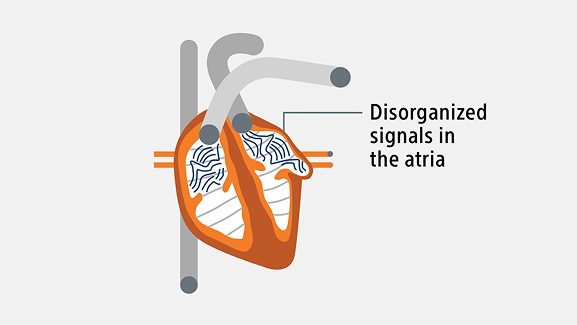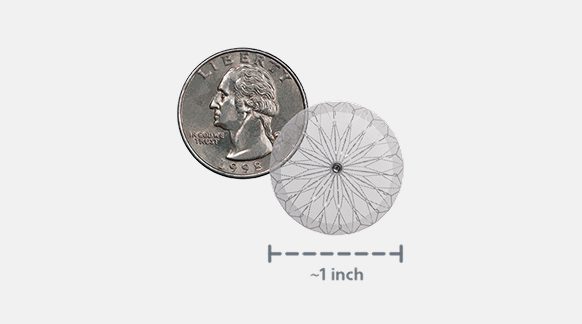The WATCHMAN Implant is a safe, minimally-invasive, one-time implant that can reduce the risk of stroke from non-valvular atrial fibrillation (NV-AFib). It’s an alternative to blood thinners for people who need one.
There are risks associated with all medical procedures. Please talk with your doctor about the risks and benefits of the WATCHMAN Implant.
Why does AFib increase stroke risk?
People with AFib have a stroke risk 5 times higher than people with a regular heartbeat.1
In AFib, the heart’s electrical system doesn’t work the way it should. As a result, the atria (the upper chambers of the heart) beat irregularly. An irregular heartbeat isn’t as good at pumping blood out of the heart, causing some blood to pool in the atria. When blood sits for too long, blood cells can stick together to form a blood clot. If a blood clot is pumped out of the heart, it can block blood vessels in the brain, causing a stroke.2

How does the WATCHMAN Implant reduce stroke risk?
The WATCHMAN Implant is designed to close off the left atrial appendage (LAA) in the heart — a part of the left atrium (an upper chamber of the heart). More than 90% of stroke-causing blood clots are formed in the LAA.3 Closing off the LAA prevents blood clots in the LAA from entering the bloodstream.
Who can get the WATCHMAN Implant for AFib?
The WATCHMAN Implant is a one-time procedure for people who need an alternative to blood thinners to reduce their stroke risk. If you have non-valvular AFib (NVAF) and need an alternative to blood thinners to manage your stroke risk, the WATCHMAN Implant may be an option.
Unlike blood thinner medications, which require ongoing monthly prescription costs, the WATCHMAN Implant is a one-time cost for life-long stroke prevention. Hear from people who’ve been there and left blood thinners behind thanks to the WATCHMAN Implant.
Find out if you’re a candidate for the WATCHMAN Implant. Take the quiz
How do you get the WATCHMAN Implant?
The WATCHMAN Implant is a permanent device that’s placed into the LAA in a one-time, minimally invasive procedure. As a permanent device, you won’t need additional procedures to replace it in the future. The device is about the size of a quarter and made from high-quality materials commonly used in medical implants.

To place the WATCHMAN Implant, your doctor will give you anesthesia, then insert the device by guiding a thin tube from a small opening in your upper leg to your heart. Once the device is inserted, your own heart tissue will grow over it and permanently seal off the LAA to prevent blood clots from forming. After the procedure, most people can return home in one day or less. Learn more about the WATCHMAN Implant procedure.
Due to the risk of having a medical procedure, patients should not be considered for the WATCHMAN Implant if they are doing well and expect to continue doing well on blood thinners.

Freedom from blood thinners
96% of people stopped their blood thinners 45 days after the WATCHMAN Implant procedure.*4 This one-time procedure provides a lifetime of stroke prevention without blood thinner medications and the lifestyle limitations that comes with them.
Talk to your doctor to see if the WATCHMAN Implant is right for you.
Already took the quiz? Return to your personalized experience.
*In a clinical trial, 96% of patients were able to discontinue their blood thinner 45 days after getting the WATCHMAN Implant.
References:
FAQ About AFib. American Heart Association, Inc., 2023. Available at: www.heart.org/-/media/Files/Health-Topics/Atrial-Fibrillation/FAQ-About-AFib.pdf. Accessed June 10, 2024.
Atrial Fibrillation (Afib). Cleveland Clinic. Available at: https://my.clevelandclinic.org/health/diseases/16765-atrial-fibrillation-afib. Accessed June 10, 2024.
Blackshear JL, Odell JA. Appendage obliteration to reduce stroke in cardiac surgical patients with atrial fibrillation. Ann Thorac Surg. 1996;61:755-759.
Kar S., Doshi S., Sadhu A., et al. Primary Outcome Evaluation of the Next Generation LAAC Device: Results from the PINNACLE FLX Trial. Circulation. 2021;143:1754–1762.
All images are the property of Boston Scientific. All trademarks are the property of their respective owners.
Content on this web page is for Informational Purposes only and does not constitute medical advice and should not be used for medical diagnoses. Boston Scientific strongly recommends that you consult with your physician on all matters pertaining to your health or to address any clinical/medical questions.
Important Safety Information
The WATCHMAN FLX and WATCHMAN FLX Pro Devices are permanent implants designed to close the left atrial appendage in the heart in an effort to reduce the risk of stroke.
With all medical procedures there are risks associated with the implant procedure and the use of the device. The risks include, but are not limited to, accidental puncture of the heart causing fluid to collect around the heart possibly leading towards the need for an additional procedure, allergic reaction, anesthesia risks, altered mental status or confusion after procedure, arrhythmias (irregular heartbeats), bleeding or throat pain from the TEE (Trans Esophageal Echo) probe, chest pain/discomfort, congestive heart failure, renal failure, excessive bleeding, gastrointestinal bleeding, groin puncture bleed, bruising at the catheter insertion site, groin pain, anemia (reduced red blood cells requiring transfusion), hypotension, infection/pneumonia (example: in or around your heart or lungs), misplacement of the device, improper seal of the appendage or movement of device from appendage wall, clot formation on the device, blood clot or air bubbles in the lungs or other organs, stroke, transient ischemic attack (temporary stroke-like symptoms), cranial bleed (bleeding in or around your brain), thrombosis (blockage of a blood vessel or vein by a clot) and in rare cases death can occur.
Be sure to talk with your doctor so that you thoroughly understand all of the risks and benefits associated with the implantation of the device. SH-2109508-AA

